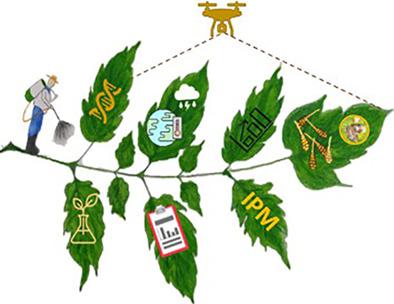当前位置:
X-MOL 学术
›
Pest Manag. Sci.
›
论文详情
Our official English website, www.x-mol.net, welcomes your feedback! (Note: you will need to create a separate account there.)
Review: Holistic pest management against early blight disease towards sustainable agriculture
Pest Management Science ( IF 4.1 ) Pub Date : 2021-02-04 , DOI: 10.1002/ps.6320 Keiji Jindo 1 , Albartus Evenhuis 2 , Corné Kempenaar 1 , Cláudia Pombo Sudré 3 , Xiaoxiu Zhan 4 , Misghina Goitom Teklu 1 , Geert Kessel 2
Pest Management Science ( IF 4.1 ) Pub Date : 2021-02-04 , DOI: 10.1002/ps.6320 Keiji Jindo 1 , Albartus Evenhuis 2 , Corné Kempenaar 1 , Cláudia Pombo Sudré 3 , Xiaoxiu Zhan 4 , Misghina Goitom Teklu 1 , Geert Kessel 2
Affiliation

|
Alternaria species are well-known aggressive pathogens that are widespread globally and warmer temperatures caused by climate change might increase their abundance more drastically. Early blight (EB) disease, caused mainly by Alternaria solani, and brown spot, caused by Alternaria alternata, are major concerns in potato, tomato and eggplant production. The development of EB is strongly linked to varieties, crop development stages, environmental factors, cultivation and field management. Several forecasting models for pesticide application to control EB were created in the last century and more recent scientific advances have included modern breeding technology to detect resistant genes and precision agriculture with hyperspectral sensors to pinpoint damage locations on plants. This paper presents an overview of the EB disease and provides an evaluation of recent scientific advances to control the disease. First of all, we describe the outline of this disease, encompassing biological cycles of the Alternaria genus, favorite climate and soil conditions as well as resistant plant species. Second, versatile management practices to minimize the effect of this pathogen at field level are discussed, covering their limitations and pitfalls. A better understanding of the underlying factors of this disease and the potential of novel research can contribute to implementing integrated pest management systems for an ecofriendly farming system. © 2021 The Authors. Pest Management Science published by John Wiley & Sons Ltd on behalf of Society of Chemical Industry.
中文翻译:

回顾:针对早疫病的整体虫害管理朝着可持续农业发展
链格孢属物种是众所周知的侵略性病原体,在全球范围内广泛传播,气候变化引起的温度升高可能会更大幅度地增加它们的丰度。早疫病 (EB) 病,主要由Alternaria solani和褐斑病,由Alternaria alternata引起, 是马铃薯、番茄和茄子生产中的主要问题。EB 的发展与品种、作物发育阶段、环境因素、栽培和田间管理密切相关。上个世纪创建了几种用于控制 EB 的杀虫剂应用预测模型,最近的科学进步包括现代育种技术以检测抗性基因和使用高光谱传感器精确定位植物损伤位置的精准农业。本文概述了 EB 疾病,并对控制该疾病的最新科学进展进行了评估。首先,我们描述了这种疾病的轮廓,包括链格孢属的生物循环属、最喜欢的气候和土壤条件以及抗性植物物种。其次,讨论了在田间最大限度地减少这种病原体影响的通用管理实践,涵盖了它们的局限性和陷阱。更好地了解这种疾病的潜在因素和新研究的潜力有助于为生态友好的农业系统实施综合虫害管理系统。© 2021 作者。John Wiley & Sons Ltd 代表化学工业协会出版的《害虫管理科学》。
更新日期:2021-02-04
中文翻译:

回顾:针对早疫病的整体虫害管理朝着可持续农业发展
链格孢属物种是众所周知的侵略性病原体,在全球范围内广泛传播,气候变化引起的温度升高可能会更大幅度地增加它们的丰度。早疫病 (EB) 病,主要由Alternaria solani和褐斑病,由Alternaria alternata引起, 是马铃薯、番茄和茄子生产中的主要问题。EB 的发展与品种、作物发育阶段、环境因素、栽培和田间管理密切相关。上个世纪创建了几种用于控制 EB 的杀虫剂应用预测模型,最近的科学进步包括现代育种技术以检测抗性基因和使用高光谱传感器精确定位植物损伤位置的精准农业。本文概述了 EB 疾病,并对控制该疾病的最新科学进展进行了评估。首先,我们描述了这种疾病的轮廓,包括链格孢属的生物循环属、最喜欢的气候和土壤条件以及抗性植物物种。其次,讨论了在田间最大限度地减少这种病原体影响的通用管理实践,涵盖了它们的局限性和陷阱。更好地了解这种疾病的潜在因素和新研究的潜力有助于为生态友好的农业系统实施综合虫害管理系统。© 2021 作者。John Wiley & Sons Ltd 代表化学工业协会出版的《害虫管理科学》。



























 京公网安备 11010802027423号
京公网安备 11010802027423号